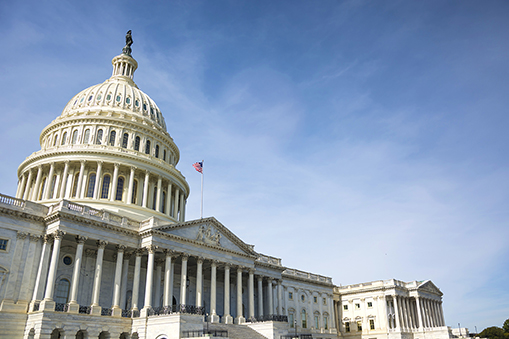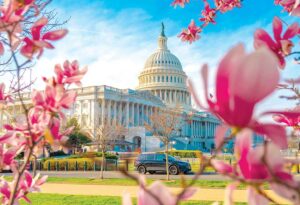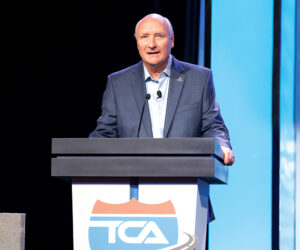The months preceding the expiration of a highway reauthorization bill normally feature a whirlwind of activity, but a new bill is rarely passed and signed into law before the expiration date. The current bill, Fixing America’s Surface Transportation (FAST) Act, which was passed in 2015, expires Sept. 30. Before the FAST Act was passed in late 2015, Congress had to pass 13 continuing resolutions (CRs), thus throwing the nation’s surface transportation enterprise, and the millions of jobs that come with it, into a period of uncertainty. There’s little question that there will be CRs of the FAST Act, but at least the next highway reauthorization process is formally underway with the Democrats’ introduction of the Investing in a New Vision for the Environment and Surface Transportation in America (INVEST in America) Act. This issue’s lead Capitol Recap article outlines the details of that bill.
NEW HIGHWAY REAUTHORIZATION BILL
House Transportation & Infrastructure Committee Chairman Peter DeFazio (D-OR-4) on June 8 introduced the Investing in a New Vision for the Environment and Surface Transportation (INVEST) in America Act.
DeFazio said INVEST in America is a key component of the Moving Forward Framework that House Democrats introduced earlier this year. The current Fixing America’s Surface Transportation (FAST) Act, which provides authorization for federal surface transportation programs, expires Sept. 30.
“The INVEST in America Act, which enables the completion of critical projects through long-term, sustainable funding and is fueled by American workers and ingenuity, thanks to strong Buy America provisions and labor protections, authorizes nearly $500 billion over five years to address some of the country’s most urgent infrastructure needs,” said DeFazio.
Truckload Carriers Association Vice President of Government Affairs David Heller shared that TCA is in the process of examining the bill’s contents.
“We are encouraged by the dialogue regarding this important issue and finally moving the needle on meaningful infrastructure legislation that will be the framework of freight transportation for years to come. We remain committed to being actively involved in these discussions and communicating the positions of TCA with all parties involved,” said Heller. “The effects of our nation’s crumbling infrastructure, as well as various other aspects of the bill, certainly present TCA with another opportunity to tell our story to our congressional leadership in an effort to fully educate them on the issues that present themselves in this legislation.”
DeFazio said the nation’s infrastructure needs include:
- Tackling the massive backlog of roads, bridges, and transit systems in need of repair and replacement.
- Building resilient infrastructure that will withstand the impacts of climate change and extreme weather.
- Designing streets that are safer for all road users, including pedestrians and cyclists.
- Putting the U.S. on a path toward zero emissions from the transportation sector by prioritizing carbon pollution reduction, investing in public transit and the national rail network, building out fueling infrastructure for low- and zero-emission vehicles, and deploying technology and innovative materials.
- Sharply increasing funding for public transit options in urban, suburban, and rural areas in order to integrate technology and increase routes and reliability with tools such as bus-only lanes and priority signaling; and
- Improving access to federal funding to help communities around the country undertake transformative projects that are smarter, safer, and made to last.
In introducing the bill, DeFazio pointed to the plight of the nation’s infrastructure.
“The bulk of our nation’s infrastructure — our roads, bridges, public transit, and rail systems, the things that hundreds of millions of American families and businesses rely on every single day — is not only badly outdated, in many places it’s downright dangerous and holding our economy back,” he said.
“Yet for decades, Congress has repeatedly ignored the calls for an overhaul and instead simply poured money into short-term patches,” he continued. “The result? We’re still running our economy on an inefficient, 1950s-era system that costs Americans increasingly more time and money while making the transportation sector the nation’s biggest source of carbon pollution.”
DeFazio said the INVEST in America Act is an opportunity to replace the outdated systems of the past with smarter, safer, more resilient infrastructure that fits the economy of the future, creates millions of jobs, supports American manufacturing, and restores U.S. competitiveness.
INFRASTRUCTURE BILL NEEDED, CVTA SAYS
Don Lefeve, president of the Commercial Vehicle Training Association (CVTA) says that as the nation transitions from stay-at-home orders to slowly reopening amidst the COVID-19 pandemic’s wake, Congress has a bipartisan opportunity to rebuild the nation’s roads, bridges, and other infrastructure while also enhancing the nation’s economy.
The trucking industry, which has long supported an infrastructure package, would benefit not only from the positive economic effect produced from the passage of such a bill, but the bill would also aid America’s truck drivers, who are responsible for transporting 71% of goods, according to Lefeve.
“I think an infrastructure bill makes sense now for short- and long-term reasons because it creates more economic activity, which includes truck drivers,” he shared. “Congress has the ability to enhance our infrastructure, which is sorely needed, but it also has the added benefit of boosting employment, which helps our economy at a time when it’s desperately needed.”
Proposed in late March and supported by President Donald Trump, the infrastructure bill would provide significant funding for construction, road/bridge repairs, and other public works projects.
Lefeve said House Transportation & Infrastructure Committee Chairman Peter DeFazio (D-OR-4), also believes an infrastructure bill to be the best way to restart the economy “that would help benefit future generations.”
“Some 13,000 jobs are created per $1 billion spent on road construction,” said Lefeve. “This could be monumental for the country, as currently more than 30 million Americans have filed for unemployment since mid-March.”
As the economy begins to rebound, the infrastructure bill presents an excellent opportunity to aid those looking for work, including commercial drivers, added Lefeve.
“An infrastructure bill makes complete sense, but one major concern we have is [that] as of late May, 17 states’ DMVs remain closed and the other states are only producing limited amounts of commercial drivers as a nation,” he said. “As the economy rebounds, and assuming an infrastructure bill is completed, this creates a perfect storm where we will need more commercial drivers. We are not producing any drivers in roughly one-third of all states. This means that tens of thousands of new truck drivers cannot obtain their Commercial Learner’s Permits (CLPs) or their Commercial Driver’s Licenses (CDLs).”
Without a CLP, an individual cannot even begin the process of training — much less transition into the national supply chain as a CDL driver, said Lefeve, adding that the CVTA believes the infrastructure bill could serve as a legislative vehicle to address potential policy solutions to ensure Americans can obtain and adequately test for their CDL.
When it comes to the recent production of CDLs in normal circumstances, CVTA predicted the industry to only produce 60% in March, 10% in April, and 30% in May. The organization estimates that this amounts to a net loss of 50,000 drivers over the three-month period. For the overall year, CVTA predicts the country will produce just 60% of the CDLs that it would have if DMVs had not been closed. As many state DMVs remain closed, CVTA and other organizations have proposed federal legislation that would give temporary authority to the Secretary of Transportation to issue temporary CLPs and CDLs through third-party entities.
“For infrastructure, you need to move goods and materials. This starts with commercial drivers and maintaining a pipeline of new drivers,” said Lefeve. “There will be a need to expand drivers. The infrastructure of the DMVs and testing needs to be evaluated. We are only as good as our ability to test.”
NATION EXPERIENCES DECLINE IN FATALITIES IN 2019
The National Highway Traffic Safety Administration (NHTSA) has released preliminary estimates for the Fatality Analysis Reporting System (FARS) 2019 data on highway crashes showing a continued decline in traffic fatalities.
The nation experienced a decline in traffic deaths during 2018 and 2017, and these newest estimates suggest a continuing decline in traffic-related deaths.
“Safety is our top priority, so this report that traffic fatalities appear to have decreased again for the third year is great news,” said U.S. Department of Transportation Secretary Elaine L. Chao.
Fatalities decreased in most major traffic safety categories:
- Drivers (down 3%).
- Passengers (down 4%).
- Motorcyclists (down 1%).
- Pedestrians (down 2%).
- Pedalcyclists (down 3%).
A statistical projection of traffic fatalities for 2019 shows that an estimated 36,120 people died in motor vehicle traffic crashes, representing an estimated decrease of about 440 (down 1.2%) from the reported 36,560 fatalities in 2018, even though Vehicle Miles Traveled (VMT) increased by 0.9%.
As a result, the fatality rate for 2019 was 1.10 fatalities per 100 million VMT, down from 1.13 fatalities per 100 million VMT in 2018. If these estimates are reflected in the final data, the fatality rate per 100 million VMT would be the second lowest since NHTSA started recording fatal crash data.
This new data also shows that nine out of 10 NHTSA regions are estimated to have decreases in traffic-related fatalities in 2019.
“Providing effective behavioral safety programs is one of NHTSA’s top safety missions,” said NHTSA Deputy Administrator James Owens. “And we know that without the unyielding efforts from our determined and passionate safety partners at the state and local levels, we could never achieve the projected drop in traffic-related fatalities that have been announced today.”
Fatalities in crashes involving at least one large truck are expected to increase slightly by 1% in 2019. The FARS data do not distinguish if the large trucks are privately owned. FARS counts or estimates large trucks as those with a gross vehicle weight rating greater than 10,000 pounds, on a public highway, involved in crashes. This includes large pickup trucks.
Last year, the department established an intermodal truck and bus working group that focuses on increasing safety and reducing truck- and bus-related crashes.
NHTSA has accelerated its efforts to continue the decline of traffic fatalities.
In February, NHTSA released $562 million in grants for highway safety programs to the Offices of Highway Safety in all 50 states, the District of Columbia, U.S. territories, and the U.S. Department of the Interior’s Bureau of Indian Affairs. The grants were issued to help state and local law-enforcement agencies enhance traffic-safety efforts to combat risky driving behaviors.
The fatality counts for 2018 and 2019 and the ensuing percentage change from 2018 to 2019 will be further revised when the final file for 2018 and the annual reporting file for 2019 become available later this year. These estimates may be further refined when the projections for the first quarter of 2020 are released in late spring.
SPEEDING TO BE FOCUS OF CVSA WEEK
The Commercial Vehicle Safety Alliance’s (CVSA) 2020 Operation Safe Driver Week will go on as scheduled July 12-18. This year, the event will be primarily focused on speeding.
During the weeklong traffic-enforcement safety initiative, law enforcement throughout North America will look for drivers who are engaging in unsafe driving behaviors. Identified drivers will be pulled over and may be issued a warning or citation.
According to the Governors Highway Safety Association (GHSA), having less traffic on the highways during the COVID-19 pandemic may be encouraging some drivers to ignore traffic safety laws, including speed limits. Many jurisdictions report seeing a severe spike in speeding despite the lighter volume of traffic.
As the number of vehicles on roadways decreased in March and April, average speeds measured during the first week of April increased significantly in the five largest U.S. metropolitan areas. According to recent data, the average speed on interstate highways, state highways, and expressways in those areas increased by as much as 75% compared to January and February.
In New York City, transportation officials reported an increase of more than 60% in the number of speed-camera tickets issued in March compared to a year ago. At the same time, traffic was down more than 90% compared to January.
In Washington, D.C., traffic decreased 80% in March compared to January, while officials recorded a 20% increase in March speeding tickets. Of those tickets, violations for driving 21 to 25 mph over the speed limit rose by nearly 40%.
During just one weekend, in Toronto, Ontario, police charged 18 drivers with stunt driving at speeds of 80 to 106 mph on the Don Valley Parkway, a major freeway that is limited to 55 mph.
California reported an increase in speeding violations, and although the California Highway Patrol’s call volume has decreased, the crashes they have recently responded to have been worse.
In Tucson, Arizona, police reported a 40% increase in one-vehicle wrecks, which usually happen when a driver is going fast enough that they lose control of the vehicle.
In Minnesota, motor-vehicle crashes and fatalities more than doubled compared to the same time period in previous years. Half of those deaths were related to speeding or careless or negligent driving.
In Colorado, Indiana, Nebraska, and Utah, police have clocked highway speeds of more than 100 mph.
Chicago and Los Angeles reported travel speed increases of 35% to 38% above average to 74% to 75% above average in just one week.
To address this trend of increased speeding on North American roadways during the pandemic, CVSA selected speeding as the focus for this year’s Operation Safe Driver Week.
“It’s essential that this enforcement initiative, which focuses on identifying and deterring unsafe driving behaviors, such as speeding, go on as scheduled,” said CVSA President Sgt. John Samis with the Delaware State Police. “As passenger vehicle drivers are limiting their travel to necessary trips and many commercial motor vehicle drivers are busy transporting vital goods to stores, it’s more important than ever to monitor our roadways for safe transport.”
Historically, drivers’ actions have contributed to 94% of all traffic crashes, according to the National Highway Traffic Safety Administration’s (NHTSA) Traffic Safety Facts Report. In addition, although NHTSA’s 2018 highway crash fatality data showed a 2.4% decline in overall fatalities, the number of fatal crashes involving large trucks increased by 0.9%.
“While, of course, we’re pleased to see a decrease in the overall number of fatalities, it was also devastating to learn that the number of fatalities involving large trucks increased. Any increase whatsoever in roadway fatalities is unacceptable,” said Samis.
HUGE SUPPORT FOR ANTI-TRAFFICKING PUSH
In January, U.S. Department of Transportation (DOT) Secretary Elaine Chao called on the nation’s transportation industry to “put the brakes on human trafficking.” Chao asked for 100 pledges within a 100-day period from industry organizations to train employees to fight the crime of human trafficking and help raise public awareness of the growing problem.
Recently, the DOT revealed that more than 200 transportation-industry leaders have answered the Secretary’s call to help fight human trafficking. The commitment has come from transportation, labor, and nongovernmental organizations across the country. The signatories represent leaders across all modes of transportation, in addition to leaders of organizations that intersect with transportation, who have committed to raising public awareness regarding human trafficking and to training more than one million employees to help fight the crime.
“Over 200 transportation organizations — double the original goal — are joining the department to ensure that America’s transportation systems are not hijacked to facilitate human trafficking. These companies are on the front lines of helping to ensure the safety of our traveling public,” said Chao.
In late January, Chao announced a series of efforts to combat human trafficking in the transportation sector. Among those efforts, she called upon transportation leaders to take a public stand against human trafficking by signing DOT’s “Transportation Leaders Against Human Trafficking” pledge. To date, more than 450 transportation industry leaders have signed the pledge, and the DOT continues to invite additional transportation leaders to join the effort.
The Truckload Carriers Association stepped up to support the initiative during the Agency’s “100 Pledges in 100 Days” event in Washington, D.C., in late January.
Secretary Chao said human trafficking is modern-day slavery, affecting nearly 25 million adults and children in the U.S. and worldwide. Victims are of every age, race, gender, background, citizenship, and immigration status. Some are trafficked within their own communities, while others are transported to new locations using America’s roadways, airways, railways, and waterways.
In addition to DOT’s commitment to prevent human trafficking, Secretary Chao established an annual $50,000 “Combating Human Trafficking in Transportation Impact Award” to provide added incentive for individuals and entities to think creatively in developing innovative solutions to combat human trafficking in the transportation industry. DOT received applications from organizations across the private sector as well as from state and local government organizations.
Secretary Chao revealed the United Against Slavery’s (UAS) National Outreach Survey for Transportation as the first-ever recipient of this award.
UAS proposed a national countertrafficking survey of up to 15,000 respondents, with the results made available to the public. This effort could either expand upon a current UAS flight-attendant survey to include other public-facing aviation employees or be conducted within another mode of transportation.
Busing on the Lookout, a program of Truckers Against Trafficking, earned second place for its proposal targeting human-trafficking loopholes that exist between buses and casinos. ArtWorks for Freedom earned third place for Airports to Freedom, a proposal to install a multimedia countertrafficking educational kiosk in up to nine airports to educate and engage the aviation industry and traveling public.
To learn more about this initiative or to get involved, visit www.transportation.gov/TLAHT/TakeAction.
FMCSA INITIATES CDL RULE FOR DRUG, ALCOHOL ABUSERS
Under new rules proposed by the Federal Motor Carrier Safety Administration (FMCSA), state driver’s licensing agencies (SDLAs) would be prohibited from issuing, renewing, upgrading, or transferring a commercial driver’s license (CDL) or commercial learner’s permit (CLP) for drivers who have been barred from operating a commercial motor vehicle (CMV) because of drug or alcohol violations.
The proposal is designed to provide real-time information from the FMCSA’s Commercial Driver’s License Drug and Alcohol Clearinghouse to SDLAs to keep drivers with drug or alcohol offenses off the road until they comply with return-to-duty requirements.
The notice of proposed rulemaking (NPRM), posted April 28, calls for SDLAs to check commercial license applicants’ status in the Clearinghouse. If the results show a driver is prohibited from operating a CMV, the Agency would be required to deny licensing. Affected drivers could re-apply for licensing after completing return-to-duty requirements. The notice also outlines how state licensing agencies would use Clearinghouse information to help enforce CMV driving prohibitions.
As an alternative, FMCSA proposes that SDLAs receive “push” notifications from the Drug and Alcohol Clearinghouse indicating when drivers licensed within the state are prohibited from operating a CMV.
“Currently, most states are not aware when a CDL holder licensed in their state is prohibited from driving a CMV due to an alcohol or drug testing violation,” noted the proposal. “Consequently, there is no federal requirement that SDLAs take any action on the license of drivers subject to that prohibition. As a result, a driver can continue to hold a valid CLP or CDL, even while prohibited from operating a CMV under FMCSA’s drug and alcohol regulations.”
This alternative proposes a licensing downgrade to align a driver’s licensing status with his or her current CMV driving status, closing a current loophole in regulations. To achieve the mandatory downgrade, SDLAs would change CDL and CLP holders’ commercial status from “licensed” to “eligible.”
FMCSA’s proposal also addresses operational questions and legal considerations identified by SDLAs, both individually and through the American Association of Motor Vehicle Administrators.
FOOD TRUCKS PERMITTED
The Federal Highway Administration (FHWA) in April issued a notice to state departments of transportation that the Agency is suspending enforcement measures under the federal-aid highway program for states that choose to permit commercial food trucks to operate and sell food, in accordance with state laws, in designated federally funded interstate-highway rest areas.
“America’s commercial truck drivers are working day and night during this COVID-19 pandemic to ensure critical relief supplies are being delivered to our communities,” said FHWA Administrator Nicole R. Nason. “I am grateful to our state transportation partners for bringing this idea to the department and for their leadership in thinking outside the box. It is critical to make sure truck drivers continue to have access to food services while they’re on the job, serving our nation during these challenging times.”
By statute, commercial activity in the federally funded interstate right-of-way is prohibited, with limited exceptions. The FHWA administrator has the discretion to take any action deemed appropriate to bring a state into compliance with these federal requirements.
However, given the extreme and unprecedented nature of the COVID-19 pandemic, Nason has chosen not to take remedial measures against states that allow food trucks to provide food in rest areas off the federally funded interstate right-of-way for the duration of the national emergency declared by President Donald Trump in response to the COVID-19 public-health crisis.
Since these actions are temporary, states must come back into compliance with federal law once the presidentially declared emergency ends. Any states that do not come back into compliance after the emergency is over may be subject to remedial measures designed to achieve compliance.
Lyndon Finney’s publishing career spans over 55 years beginning with a reporter position with the Southwest Times Record in Fort Smith, Arkansas, in 1965. Since then he’s been a newspaper editor at the Southwest Times Record, served five years as assistant managing editor of the Arkansas Democrat-Gazette in Little Rock and from November 2004 through December 2019 served as editor of The Trucker. Between newspaper jobs he spent 14 years as director of communications at Baptist Health, Arkansas’ largest healthcare system. In addition to his publishing career he served for 46 years as organist at Little Rock’s largest Baptist church.








